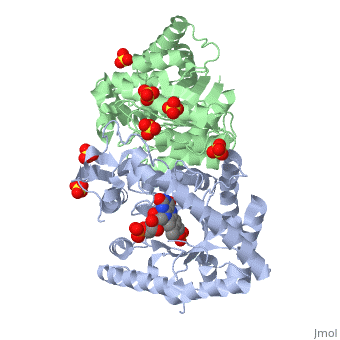|
|
| Line 3: |
Line 3: |
| | <StructureSection load='3fgc' size='340' side='right'caption='[[3fgc]], [[Resolution|resolution]] 2.30Å' scene=''> | | <StructureSection load='3fgc' size='340' side='right'caption='[[3fgc]], [[Resolution|resolution]] 2.30Å' scene=''> |
| | == Structural highlights == | | == Structural highlights == |
| - | <table><tr><td colspan='2'>[[3fgc]] is a 4 chain structure with sequence from [https://en.wikipedia.org/wiki/"achromobacter_harveyi"_johnson_and_shunk_1936 "achromobacter harveyi" johnson and shunk 1936]. Full crystallographic information is available from [http://oca.weizmann.ac.il/oca-bin/ocashort?id=3FGC OCA]. For a <b>guided tour on the structure components</b> use [https://proteopedia.org/fgij/fg.htm?mol=3FGC FirstGlance]. <br> | + | <table><tr><td colspan='2'>[[3fgc]] is a 4 chain structure with sequence from [https://en.wikipedia.org/wiki/Vibrio_harveyi Vibrio harveyi]. Full crystallographic information is available from [http://oca.weizmann.ac.il/oca-bin/ocashort?id=3FGC OCA]. For a <b>guided tour on the structure components</b> use [https://proteopedia.org/fgij/fg.htm?mol=3FGC FirstGlance]. <br> |
| - | </td></tr><tr id='ligand'><td class="sblockLbl"><b>[[Ligand|Ligands:]]</b></td><td class="sblockDat" id="ligandDat"><scene name='pdbligand=FMN:FLAVIN+MONONUCLEOTIDE'>FMN</scene>, <scene name='pdbligand=PO4:PHOSPHATE+ION'>PO4</scene>, <scene name='pdbligand=SO4:SULFATE+ION'>SO4</scene></td></tr> | + | </td></tr><tr id='method'><td class="sblockLbl"><b>[[Empirical_models|Method:]]</b></td><td class="sblockDat" id="methodDat">X-ray diffraction, [[Resolution|Resolution]] 2.3Å</td></tr> |
| - | <tr id='related'><td class="sblockLbl"><b>[[Related_structure|Related:]]</b></td><td class="sblockDat"><div style='overflow: auto; max-height: 3em;'>[[1luc|1luc]], [[1brl|1brl]]</div></td></tr>
| + | <tr id='ligand'><td class="sblockLbl"><b>[[Ligand|Ligands:]]</b></td><td class="sblockDat" id="ligandDat"><scene name='pdbligand=FMN:FLAVIN+MONONUCLEOTIDE'>FMN</scene>, <scene name='pdbligand=PO4:PHOSPHATE+ION'>PO4</scene>, <scene name='pdbligand=SO4:SULFATE+ION'>SO4</scene></td></tr> |
| - | <tr id='gene'><td class="sblockLbl"><b>[[Gene|Gene:]]</b></td><td class="sblockDat">luxA ([https://www.ncbi.nlm.nih.gov/Taxonomy/Browser/wwwtax.cgi?mode=Info&srchmode=5&id=669 "Achromobacter harveyi" Johnson and Shunk 1936]), luxB ([https://www.ncbi.nlm.nih.gov/Taxonomy/Browser/wwwtax.cgi?mode=Info&srchmode=5&id=669 "Achromobacter harveyi" Johnson and Shunk 1936])</td></tr> | + | |
| - | <tr id='activity'><td class="sblockLbl"><b>Activity:</b></td><td class="sblockDat"><span class='plainlinks'>[https://en.wikipedia.org/wiki/Alkanal_monooxygenase_(FMN-linked) Alkanal monooxygenase (FMN-linked)], with EC number [https://www.brenda-enzymes.info/php/result_flat.php4?ecno=1.14.14.3 1.14.14.3] </span></td></tr> | + | |
| | <tr id='resources'><td class="sblockLbl"><b>Resources:</b></td><td class="sblockDat"><span class='plainlinks'>[https://proteopedia.org/fgij/fg.htm?mol=3fgc FirstGlance], [http://oca.weizmann.ac.il/oca-bin/ocaids?id=3fgc OCA], [https://pdbe.org/3fgc PDBe], [https://www.rcsb.org/pdb/explore.do?structureId=3fgc RCSB], [https://www.ebi.ac.uk/pdbsum/3fgc PDBsum], [https://prosat.h-its.org/prosat/prosatexe?pdbcode=3fgc ProSAT]</span></td></tr> | | <tr id='resources'><td class="sblockLbl"><b>Resources:</b></td><td class="sblockDat"><span class='plainlinks'>[https://proteopedia.org/fgij/fg.htm?mol=3fgc FirstGlance], [http://oca.weizmann.ac.il/oca-bin/ocaids?id=3fgc OCA], [https://pdbe.org/3fgc PDBe], [https://www.rcsb.org/pdb/explore.do?structureId=3fgc RCSB], [https://www.ebi.ac.uk/pdbsum/3fgc PDBsum], [https://prosat.h-its.org/prosat/prosatexe?pdbcode=3fgc ProSAT]</span></td></tr> |
| | </table> | | </table> |
| | == Function == | | == Function == |
| - | [[https://www.uniprot.org/uniprot/LUXA_VIBHA LUXA_VIBHA]] Light-emitting reaction in luminous bacteria. [[https://www.uniprot.org/uniprot/LUXB_VIBHA LUXB_VIBHA]] Light-emitting reaction in luminous bacteria. The specific role of the beta subunit is unknown, but it is absolutely required for bioluminescence activity.
| + | [https://www.uniprot.org/uniprot/LUXA_VIBHA LUXA_VIBHA] Light-emitting reaction in luminous bacteria. |
| | == Evolutionary Conservation == | | == Evolutionary Conservation == |
| | [[Image:Consurf_key_small.gif|200px|right]] | | [[Image:Consurf_key_small.gif|200px|right]] |
| Line 38: |
Line 36: |
| | __TOC__ | | __TOC__ |
| | </StructureSection> | | </StructureSection> |
| - | [[Category: Achromobacter harveyi johnson and shunk 1936]] | |
| | [[Category: Large Structures]] | | [[Category: Large Structures]] |
| - | [[Category: Baldwin, T O]] | + | [[Category: Vibrio harveyi]] |
| - | [[Category: Campbell, Z T]] | + | [[Category: Baldwin TO]] |
| - | [[Category: Montfort, W R]] | + | [[Category: Campbell ZT]] |
| - | [[Category: Weichsel, A]] | + | [[Category: Montfort WR]] |
| - | [[Category: Flavoprotein]] | + | [[Category: Weichsel A]] |
| - | [[Category: Fmn]]
| + | |
| - | [[Category: Fmn bacterial luciferase mobile loop]]
| + | |
| - | [[Category: Luminescence]]
| + | |
| - | [[Category: Monooxygenase]]
| + | |
| - | [[Category: Oxidoreductase]]
| + | |
| - | [[Category: Photoprotein]]
| + | |
| Structural highlights
Function
LUXA_VIBHA Light-emitting reaction in luminous bacteria.
Evolutionary Conservation
Check, as determined by ConSurfDB. You may read the explanation of the method and the full data available from ConSurf.
Publication Abstract from PubMed
Bacterial luciferase from <i>V. harveyi</i> is a heterodimer composed of a catalytic alpha subunit and an homologous but non-catalytic beta subunit. Despite decades of enzymological investigation, structural evidence defining the active center has been elusive. We report here the crystal structure of <i>V. harveyi</i> luciferase bound to FMN at 2.3 A. The isoalloxazine ring is coordinated by an unusual <i>cis</i> Ala-Ala peptide bond. The reactive sulfhydryl group of Cys 106 projects toward position C-4a, the site of flavin-oxygenation. This structure also provides the first data specifying the conformations of a mobile loop that is crystallographically disordered in both prior crystal structures [Fisher, A. J., Raushel, F. M., Baldwin, T. O., & Rayment, I. (1995) Biochemistry 34, 6581-6586; Fisher, A. J., Thompson, T. B., Thoden, J. B., Baldwin, T. O., & Rayment, I. (1996) J. Biol. Chem. 271, 21956-21968]. This loop appears to be a boundary between solvent and the active center. Within this portion of the protein, a single contact was observed between Phe 272 of the alpha subunit, not seen in the previous structures, and Tyr 151 of the beta subunit. Substitutions at position 151 on the beta subunit caused reductions in activity and total quantum yield. Several of these mutants were found to have decreased affinity for FMNH2. These findings partially address the long-standing question of how the beta subunit stabilizes the active conformation of the alpha subunit, thereby participating in the catalytic mechanism.
Crystal Structure of the Bacterial Luciferase:Flavin Complex Provides Insight into the Function of the subunit.,Campbell ZT, Weichsel A, Montfort WR, Baldwin TO Biochemistry. 2009 May 12. PMID:19435287[1]
From MEDLINE®/PubMed®, a database of the U.S. National Library of Medicine.
See Also
References
- ↑ Campbell ZT, Weichsel A, Montfort WR, Baldwin TO. Crystal Structure of the Bacterial Luciferase:Flavin Complex Provides Insight into the Function of the subunit. Biochemistry. 2009 May 12. PMID:19435287 doi:http://dx.doi.org/10.1021/bi900003t
|


